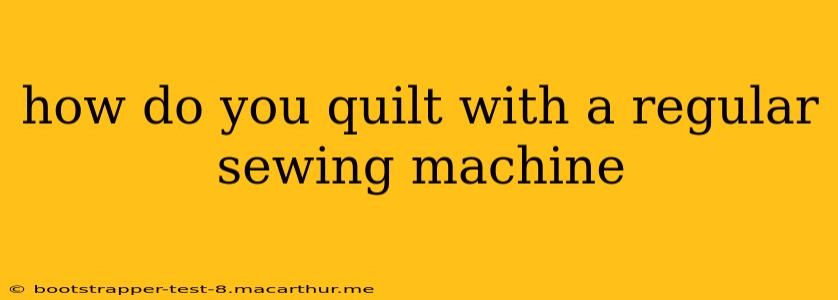Quilting, the art of stitching layers of fabric together, doesn't require a specialized machine. With a little know-how and the right techniques, you can create beautiful quilts using your regular sewing machine. This guide will walk you through the process, answering common questions along the way.
What kind of sewing machine do I need for quilting?
You don't need a fancy, expensive long-arm quilting machine to get started. A standard sewing machine with a few key features will work perfectly:
- Adjustable stitch length: This allows you to control the density of your stitching, which is crucial for quilting. Shorter stitches create more durable seams, particularly important in high-stress areas.
- Free arm: A free arm is highly beneficial for quilting, especially when working on curved seams or smaller projects. It allows you to easily maneuver the fabric around the arm of the machine. While not strictly necessary, it significantly improves ease of use.
- Sufficient power: Quilting, especially with multiple layers of fabric, requires a machine with enough power to sew smoothly without stalling.
Can I quilt on a small sewing machine?
Absolutely! Many quilters successfully use smaller, more compact sewing machines. While a larger machine might offer more space for larger projects, the size of your machine doesn't determine your quilting ability. You may find you need to quilt in sections with a smaller machine, which is perfectly acceptable.
What foot do I use for quilting?
The best foot for quilting depends on the type of quilting you're doing. Here are a few popular choices:
- Walking foot: This foot moves the layers of fabric evenly, preventing them from shifting or bunching, particularly helpful with multiple layers of thick fabric. It’s considered essential for most quilting projects.
- Free-motion quilting foot (darning foot): This foot allows for free-motion quilting, where you guide the fabric to create free-flowing designs. This requires lowering your feed dogs.
- Open-toe foot: Offers better visibility of your needle and stitching, particularly useful for intricate designs.
Remember to consult your machine's manual to determine which feet are compatible and how to attach them correctly.
How do I prepare my fabric for machine quilting?
Proper preparation is key to a successful quilting project. This involves:
- Layering: Accurately layer your batting, backing fabric, and quilt top, ensuring they're perfectly aligned and smooth. Use safety pins or basting spray to secure the layers.
- Basting: Basting is crucial to prevent layers from shifting while quilting. You can use safety pins, basting spray, or hand basting to hold everything in place.
- Pre-washing: Pre-wash your fabrics to avoid shrinkage after quilting. This also helps to remove any sizing or finishes that might affect your stitching.
What are the basic quilting stitches?
While there are many decorative stitches, the fundamental stitch for quilting is a straight stitch. However, you can use this to create a variety of patterns by changing the direction and spacing of your stitches. Experiment with different stitch lengths and try out walking foot quilting and free motion quilting to explore different options.
How do I quilt in the ditch?
"Quilting in the ditch" means stitching directly in the seam line between the quilt top pieces. This creates a clean, subtle quilting effect. It's a beginner-friendly technique and requires a walking foot and careful attention to line up your needle with the seam.
What are some tips for machine quilting beginners?
- Start small: Begin with a small project like a pillowcase or table runner to practice your techniques before tackling a larger quilt.
- Practice on scraps: Practice your quilting patterns on scraps of fabric before quilting your actual project. This helps you get a feel for your machine and the chosen stitch.
- Take breaks: Quilting can be tiring. Take breaks to avoid fatigue and maintain accuracy.
- Use a quilting guide: A quilting guide helps you maintain consistent stitching spacing and create straight lines.
- Be patient: Quilting takes time and practice. Don't get discouraged if your first attempts aren't perfect.
By following these tips and techniques, you can confidently use your regular sewing machine to create beautiful and durable quilts. Remember to always consult your sewing machine's manual for specific instructions and safety precautions. Happy quilting!
